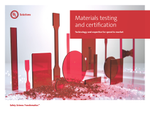
UL Materials Testing and Certification (English)
Our UL Solutions test facilities are offering the following rheological tests.

This test method is used to determine the melt mass flow rate and melt volume flow rate of polymers. A polymer melt is extruded through a standard die under the influence of a defined force and temperature. The melt mass flow rate (MFR) and the melt volume flow rate (MVR) are respectively the mass or volume of this melt that is extruded in ten minutes.
Standards for melt index
ISO 1133, ASTM D1238, JIS K7210, or equivalent standards
Melt index: Intrinsic melt mass flow rate (IMFR) - ISO 1133
Melt index: Intrinsic melt volume flow rate (IMVR) - ISO 1133
This test method is used to investigate the flow properties of polymers in a capillary rheometer.
The shear viscosity [Pas] and shear speed [1/s] are calculated from the test pressure or volume flow rate (depending on equipment type) determined during the extrusion of a plastic melt through a capillary with defined dimensions and presented as a shear viscosity function. The shear viscosity function serves as a basis for assessing the processability of a molding compound. The flow properties of a molding compound depend in turn on its molecular structure.
Standards for melt viscosity
DIN 54811*, ISO 11443, or equivalent standards
*Standard withdrawn
This test method is used to determine the viscosity number of thermoplastics.
The method involves measuring the flow times of a polymer in solution as it passes through a Ubbelohde viscometer and then establishing the difference in viscosity between the polymer solution and the solvent.
The viscosity number can then be calculated taking into account the mass concentration of the polymer solution.
The viscosity number can be correlated with a polymer’s molar mass. Molecular decomposition frequently occurs when polymers are subjected to major stress, for example during processing. This effect can be quantified by calculating the viscosity number. Molecular changes due to immersion in fluids can also be detected using this method.
Standards for solution viscosity
DIN 51562, ISO 1628-1, ISO 1628-4, or equivalent standards
This test method is used to determine the dynamic and mechanical properties of polymer melts. By determining the precise complex viscosity of a polymer melt, it is possible to calculate the limit of thermal stability. A polymer melt is exposed to a harmonic shear deformation in a plate-plate rheometer and the material response detected in the form of a harmonic shear stress. This results in the storage modulus G' as well as the loss modulus G" and the loss factor tan δ . The actual measurand, known as the complex viscosity, can then be calculated from the storage and loss moduli.
An oscillatory shear in the small amplitude range performs the function of a sampling probe during the measurement, ensuring a significantly more precise result than with tests that rely on stationary shear flow (capillary rheometer, MFR). This method can be used to quantify such variables as zero shear viscosity, the linear viscoelastic range or the thermal stability of melts with high resolution.
Standards for oscillatory shearing
ISO 6721-10, ASTM D4440, or equivalent standards
Representation of the complex viscosity of a polymer melt in a so-called “time sweep”. A 5% deviation in complex viscosity based on a melt’s initial value indicates that the thermal stability limit has been reached.
Round sheet 25 mm, thickness d = 1,7 mm

UL Materials Testing and Certification (English)
Have questions, need specifics? Let's get this conversation started.